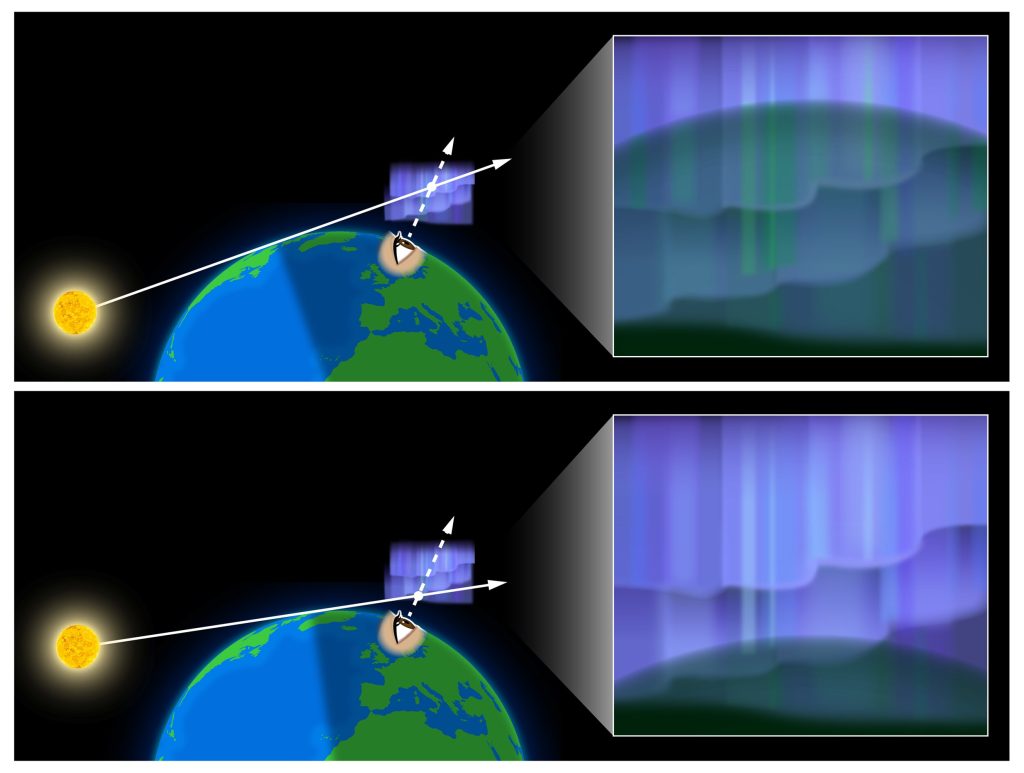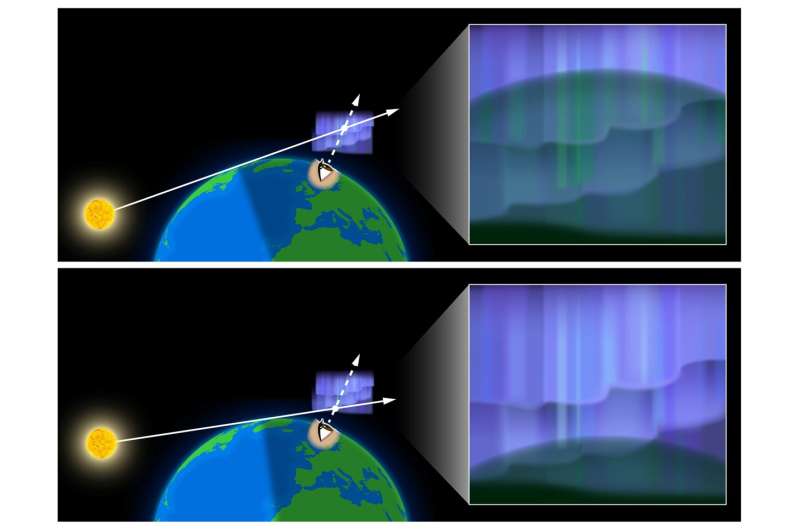Bright blue aurora creation: Hyperspectral camera records first accurate altitude distribution.

Bright blue aurora formation: Hyperspectral camera captures first precise altitude distribution (Image Credit: Phys.org)

The Institute for Fusion Science installed the Hyperspectral Camera for Auroral Imaging (HySCAI) in Kiruna, Sweden, in May 2023 and commenced full-scale observations in September of the same year. A research group has now succeeded in observing the altitude distribution of blue nitrogen ion (N₂⁺) auroras emitting light during astronomical twilight using HySCAI.
This research developed a completely novel method, utilizing the phenomenon where the altitude at which sunlight illuminates the aurora changes as twilight progresses. This enabled precise observation of the altitude distribution of the nitrogen ion’s emission intensity. The peak was found to be located at an altitude of approximately 200 km, exhibiting extremely high intensity.
Auroras are natural phenomena where electrons from space collide with Earth’s atmosphere (oxygen and nitrogen) and emit light. The various colors—red, green, purple, etc.—depend on which atoms or molecules emit light and how the energy changes. This light contains hidden information about the velocity of particles falling down and conditions of the atmosphere.
At what height do they shine?
While auroras appear to spread across the sky when viewed from the ground, determining their actual altitude has been challenging. Conventional methods involve setting up multiple cameras at different locations to capture stereoscopic images, enabling height estimation. It was believed that a single camera alone could not determine altitude.
Researchers drew inspiration from plasma studies in laboratories. There, a long-established technique involved firing a particle beam and determining depth by the intersection of the light excited by that beam and the line of sight of the observation.
This time, applied to the aurora, sunlight-excited auroral emissions (resonant scattered light) were used. By utilizing the intersection of this light and the camera’s line of sight, height estimation became possible with just one camera.
The study is published in the journal Geophysical Research Letters.
Strength of the hyperspectral camera
With ordinary cameras or filtered observations, during an astronomical twilight of dawn, sunlight reflection and resonant scattered light mix, making them difficult to distinguish. However, the hyperspectral camera can observe light color (wavelength) information in extremely fine detail, enabling it to accurately separate and capture both components.
Regarding the blue aurora observed in Kiruna, Sweden, in the early morning of October 21, 2023, the research team analyzed data using a hyperspectral camera installed by the National Institute for Fusion Science. They successfully estimated the precise altitude distribution of nitrogen molecular ions (N2+) responsible for the aurora’s emissions.
It is well known that during nighttime auroral emissions, nitrogen molecular ion emission is strongest at an altitude of approximately 130 km. However, this observation during dawn (astronomical twilight) revealed that the rate of increase in emission intensity peaks at an altitude of 200 km.
This directly indicates that, at least during twilight, the emission at the high altitude of 200 km is exceptionally strong, suggesting the possibility that nitrogen molecular ions exist at such high altitudes.
This result confirms previous observations suggesting that the density of nitrogen molecular ions at high altitudes may be higher than previously thought, while also enabling verification of theoretical models concerning the physical processes involved in aurora formation. High-precision observations using hyperspectral cameras open new avenues for aurora research.
Significance and future developments
Aurora observations using the hyperspectral camera accurately captured the temporal and altitude variations of resonance-scattered light during astronomical twilight, which had previously been difficult to quantify. Compared to conventional cameras using interference filters, it broadened the observation domain and introduced a new altitude estimation method.
This is expected to contribute to solving the long-standing problem of nitrogen molecular ion generation and outflow in the ionosphere.
Going forward, it is expected that this interdisciplinary research will advance through collaboration with universities and research institutes both domestically and internationally, contributing to the development of global aurora research.
More information:
K. Ida et al, Estimate of N2+ Altitude Profile Using Blue Auroral Resonant‐Scattering 427.8 nm Emission Observed With HySCAI During Astronomical Twilight, Geophysical Research Letters (2025). DOI: 10.1029/2025gl118375
Journal information:
Geophysical Research Letters
Provided by
National Institutes of Natural Sciences
Bright blue aurora formation: Hyperspectral camera captures first precise altitude distribution (2025, November 6)
retrieved 7 November 2025
from https://phys.org/news/2025-11-bright-blue-aurora-formation-hyperspectral.html
part may be reproduced without the written permission. The content is provided for information purposes only.




